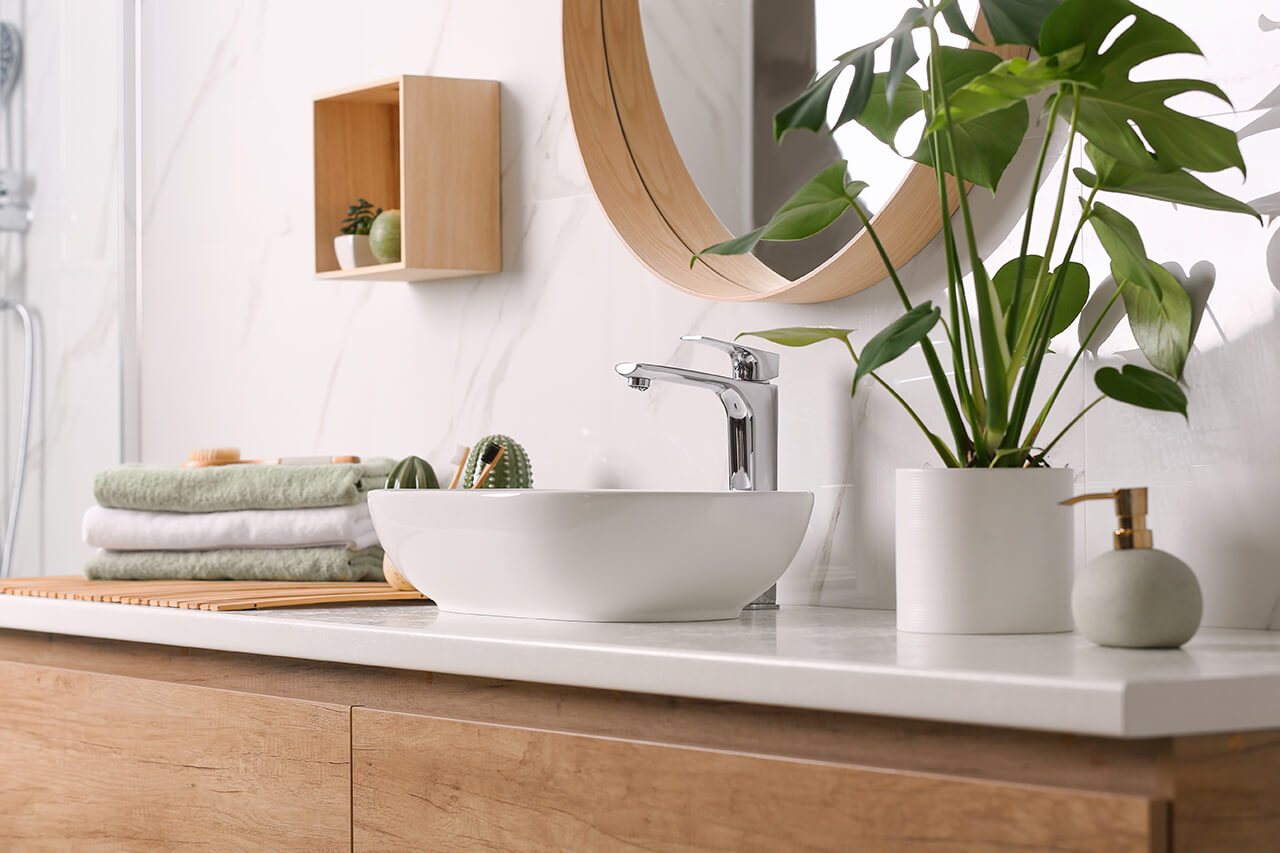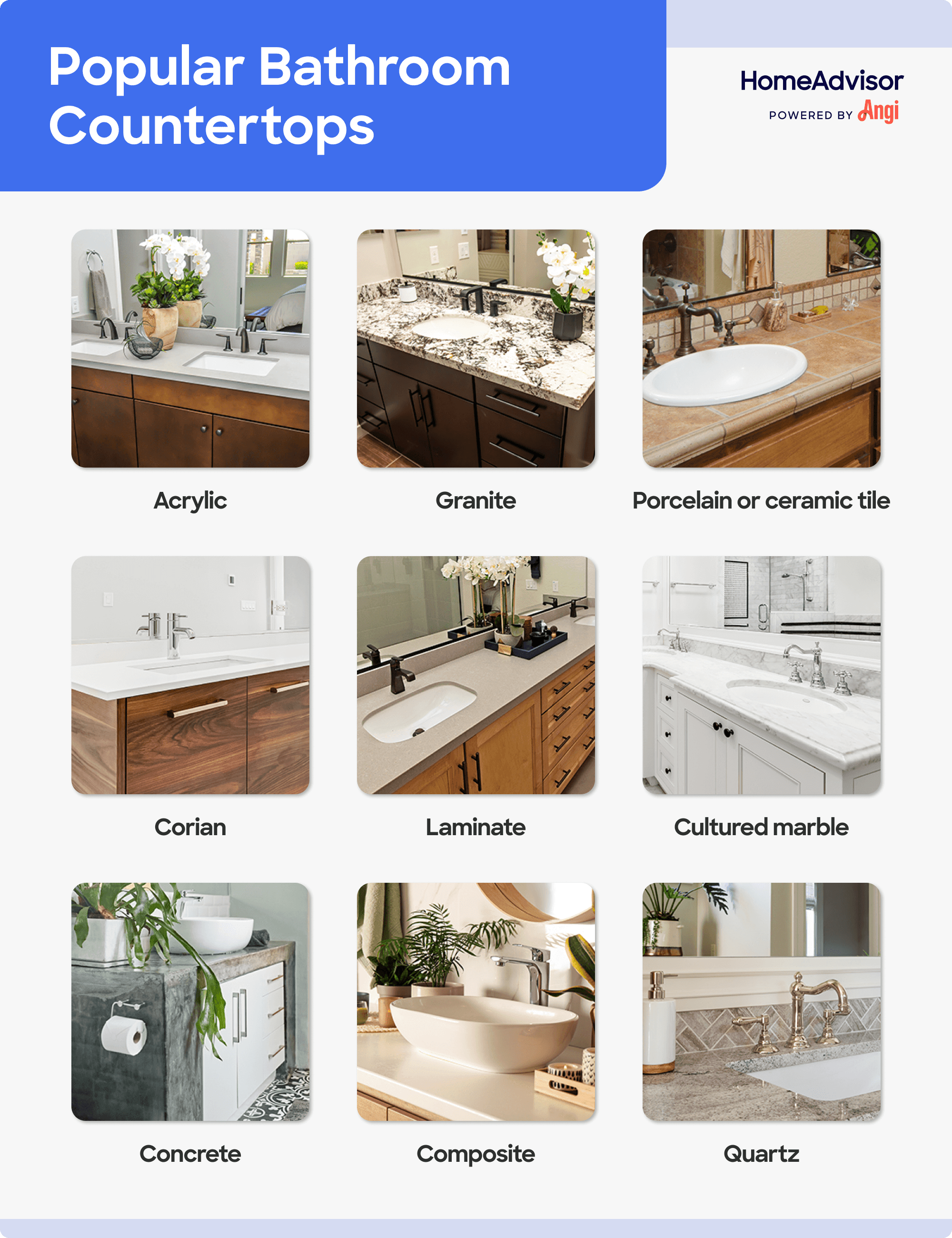
Use this guide to budget for the cost to raise a roof based on factors such as labor costs, house type, exterior finishing work, and more.
The average cost of bathroom vanity installation is $1,500


The average cost to install a bathroom vanity is $1,500, with most prices ranging between $300 and $2,200.
Costs vary based on factors such as vanity type, materials, size, and plumbing work required.
Upgrading your bathroom vanity can enhance the functionality and aesthetics of your bathroom.
Hiring a bathroom vanity professional ensures proper installation, safety, and longevity of your new vanity.
This article was updated using automation technology and thoroughly reviewed for accuracy by HomeAdvisor Editor Ryan Noonan.
The average cost to install a bathroom vanity ranges from $300 to $2,200, with most homeowners spending $1,500. This installation price varies based on the vanity type—premade or custom—materials, size, and any plumbing work required. Upgrading your bathroom vanity not only enhances the functionality of your space but also elevates its aesthetic appeal. Budgeting properly and considering professional vanity installation can ensure your new vanity looks great and lasts for years to come.
Most prefabricated bathroom vanities cost between $100 and $2,600, depending on the size, materials, and added features. Larger vanities and those made with high-end materials like granite or quartz will be on the higher end of the price range, while smaller vanities with standard materials are more budget-friendly. Here's a breakdown of average costs based on vanity size.
| Vanity Size | Average Cost Range |
|---|---|
| 2.5-foot single with countertop | $100–$500 |
| 4-foot single with countertop | $400–$700 |
| 5-foot single with countertop | $500–$1,800 |
| 6-foot single with countertop | $800–$2,100 |
| 4-foot double with countertop | $550–$1,900 |
| 5-foot double with countertop | $600–$2,200 |
If your chosen prefabricated vanity doesn't include a countertop, you'll need to purchase a custom-made or prefabricated top separately. Prices vary based on the material and design you select. Most premade vanity tops come with a built-in sink made from materials like cultured marble. Before purchasing a top, double-check that the countertop fits your vanity's dimensions.
Having a professional builder create a custom bathroom vanity costs between $500 and $2,800 for construction alone, with installation adding another $200 to $1,000 to the total cost. Unlike premade options, custom vanities often require you to purchase the countertop separately. While custom styles can be more expensive, they allow you to design a vanity that perfectly fits your space and style preferences.
Here’s how much you can expect to pay for the various elements of a custom vanity:
Building the vanity: $500 to $2,800
Countertop materials: $5 to $200 per square foot
Installation: $200 to $1,000
Cost to hire a plumber to run a water and drain line: $45 to $200 per hour
Many pros can design, build, and install the cabinet for you, but you may need to arrange for a plumber separately.

Bathroom vanity countertops range in price from $5 to $135 per square foot, depending on the material you choose, the number of sinks, and whether the sinks are built-in or separate. Selecting the right material not only impacts the overall look of your bathroom but also affects durability and maintenance.
| Material | Cost Range per Sq. Ft. |
|---|---|
| Granite | $5–$100 |
| Porcelain or ceramic tile | $7–$20 |
| Laminate | $10–$40 |
| Corian | $20–$75 |
| Cultured marble | $40–$180 |
| Concrete | $65–$135 |
| Composite | $75–$120 |
| Quartz | $50–$200 |
Granite vanity countertops cost between $5 and $100 per square foot. Granite tiles are on the lower end, from $5 to $15 per square foot, while slabs range from $40 to $100 per square foot. Granite is a popular choice for its natural beauty and durability, but it does require sealing and extra care due to its sensitivity to moisture absorption.
The price of a porcelain or ceramic tile countertop runs from $7 to $20 per square foot for materials alone. Installing this type of vanity top costs roughly $13 to $28 per square foot all in.
On average, laminate countertops cost $10 to $40 per square foot before installation. Laminate is a composite countertop material made from a mix of paper, wood, and resin, known for its low price and smooth surface.
Corian countertops cost $20 to $75 per square foot. Corian is a composite counter material that combines metal and plastic resin. Homeowners choose it for its nonporous surface and simple maintenance requirements.
On average, cultured marble countertops cost $40 to $180 per square foot. This countertop style is the most common for premade vanities, and it’s more cost-effective, yet just as good-looking, as real marble slabs.
The price of concrete countertops ranges from $65 to $135 per square foot. Concrete presents a trendy, hard-wearing look and is relatively easy to maintain, but the material is much heavier than traditional vanity countertops. Homeowners should confirm that the cabinet structure below can support the weight of this material before making any final decisions.
On average, stone composite countertops cost $75 to $120 per square foot. Like quartz, these countertops mix crushed stone with resins to provide a solid surface that is more durable and easier to maintain than a single slab of rock.
Quartz countertops cost $50 to $200 on average per square foot. In addition to being stylish, quartz is ideal for bathroom spaces because it’s more moisture-resistant than granite.
While the countertop often represents the largest expense, other factors, like sink installation, replacements, backsplash, and disposal fees, can increase your total installation cost. According to Andrew Kilborn, owner of Andy's Handyman, “A new vanity could also require repairing the wall.” Being aware of these potential additional costs can help you budget more accurately.
Contractors often include the cost of cutting a solid slab into the total labor expense of your project. More intricate shapes and edges take longer to complete, costing more as a result. Most contractors source stone countertop materials from a fabricator, who may handle the cutting, or they may do it themselves.
Installing a bathroom sink costs an average of $400, not including the sink itself, which ranges from $40 to $300. The total cost depends on the type and number of sinks and the complexity of the installation. The installation process usually involves attaching the sink to the countertop, assembling and installing the faucet, connecting the plumbing lines, and testing everything to ensure proper function.
The cost to install plumbing ranges from $400 to $2,000, averaging $1,000 for new bathroom vanities. Factors like pipe material, job size, and whether you need to remove old plumbing will determine how much you’ll pay for this project.
In general, larger vanities cost more to build because they require more materials and take longer to complete. While you may be able to spend as little as $300 on a small vanity, larger ones can cost up to $2,200 or more due to additional expenses,
The cost to install a vanity backsplash ranges from $2 to $30 per square foot, with the overall price depending on the type of material you use and the size of the project. Some pre-made vanities already include a backsplash directly built into them, so you won’t have to worry about the additional expense.
The cost to remove a vanity runs from $115 to $500, depending on the unit size and the countertop material. Larger vanities, especially those with a heavy stone or concrete slab, take longer to dismantle and incur higher costs.
While installing a simple bathroom vanity can be a DIY project for experienced homeowners, hiring a bathroom vanity professional ensures proper installation, safety, and longevity of your new vanity. Pros have the expertise to handle delicate materials, correctly assemble and place heavy equipment, and avoid costly mistakes—especially when working with solid surface countertops. To achieve the best results, consider hiring a local bathroom remodeler.
No place is more important than your home, which is why HomeAdvisor connects homeowners with local pros to transform their houses into homes they love. To help homeowners prepare for their next project, HomeAdvisor provides readers with accurate cost data and follows strict editorial guidelines. After a project is complete, we survey real customers about the costs to develop the pricing data you see, so you can make the best decisions for you and your home. We pair this data with research from reputable sources, including the U.S. Bureau of Labor Statistics, academic journals, market studies, and interviews with industry experts—all to ensure our prices reflect real-world projects.
From average costs to expert advice, get all the answers you need to get your job done.

Use this guide to budget for the cost to raise a roof based on factors such as labor costs, house type, exterior finishing work, and more.

Looking to enhance the warmth and utility of your kitchen? Explore how much a butcher block countertop costs and start your budget here.

Wondering who to hire for a kitchen remodel? Compare general contractors and kitchen remodelers on costs, timelines, and steps to get your project done.

Unsure who to hire for a home renovation? Learn whether to call a general contractor, architect, or specialty pro, and get tips to choose.

Learn how to hire historic restoration contractors. See who to call, services, average costs, and smart tips to choose the right pro.